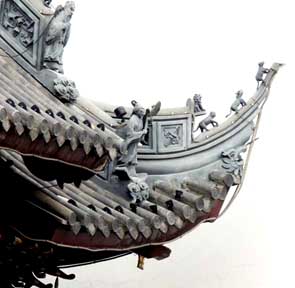
China - Table of Contents .................. Chinese Architecture Dictionary .................. Illustrated Architecture Dictionary .

China - Table of Contents .................. Chinese Architecture Dictionary .................. Illustrated Architecture Dictionary .
Classical Chinese Roofs

Most Chinese roofs had large overhangs that were not just for an artistic effect but also functioned as guard from the rain and sunlight.
The quintessentially Chinese gable-and-hip roof with pronounced dragon-spine ridges and upturned flying eaves first appeared during the Han (BCE 206 – CE 220) Dynasty.
|
Classical Chinese buildings,
especially those of the wealthy are built with an emphasis on breadth
and less on height, with close heavy platform and a large roof that
floats over this base, with the vertical walls not well emphasized. Structural beams: Use of large
structural timbers for primary support of the roof of a building.
Wooden timber, usually large trimmed logs, are used as load-bearing
columns and lateral beams for framing buildings and supporting the
roofs. These beams are connected to each other directly or in larger
and higher class structures, tied indirectly together through the use
of brackets [dougong]. Sweeping [roofs]: Roofs with a sweeping curvature that rises at the corners of the roof [flying eaves]. The types of roof construction are usually reserved for temples and palaces although it may also be found in the homes of the wealthy. In the former cases, the ridges of the roof are usually highly decorated with ceramic figurines. Roof apex: The roof apex of a large hall is usually topped with a ridge of tiles and statues for both decorative purposes but also to weight down the layers of roofing tiles for stability. These ridges are often well decorated, especially for religious or palatial structures. |
Chinese roof decoration / roof charms / roof-figures:
- Often made of glazed ceramic and form an outward marching procession.
- Each figure protects the building in a different way.
- Imperial yellow glaze reserved for the emperor.
- The number of animals, between the two figures indicates the importance of the building. The maximum number of beasts is nine.
- At the tail of the procession will be an imperial dragon, representing the authority of the state.
- Roof animals have been part of the decorations on roofs at least since the Han Dynasty (206 BC - 220 AD). Many of the figures were also found in Han funerary objects buried with the deceased to protect and feed them in the next life.
- Examples:
- Dragon called a chiwen. Protects the building from fire by controlling the rain and the sea.. Dragons are associated with water in Chinese mythology and thus have the power to extinguish fire with rain. It is the primary symbol of the imperial throne. The chiwen is one of the nine sons of the dragon king.
- Man riding a chicken
- Man riding a phoenix
- Phoenix - Phoenix is the king of birds and controls the wind and air. Bring happiness and good luck.
- Lion - King of the beasts and the most powerful of the animals. The lion protects the country and the imperial rule, indicates the power of the owner.
- Heavenly horse - Can run like the wind and travel thousands of miles in a day.
- Sea horse - Has control over water to protect buildings from fire.
- Bull - Dispels evil and fights the enemy with its horns.
- Goat-bull
- Fish - Wind-and storm-summoning
Examples:
- Illustration above: Shanghai Old Town Yuyuan Bazaar, China
- Shanghai Old Town Yuyuan Garden, China
- Flying eaves and roof dragons - Small Wild Goose Pagoda, Xi'an, China
- Forbidden City, Beijing
- Summer Palace, Beijing
